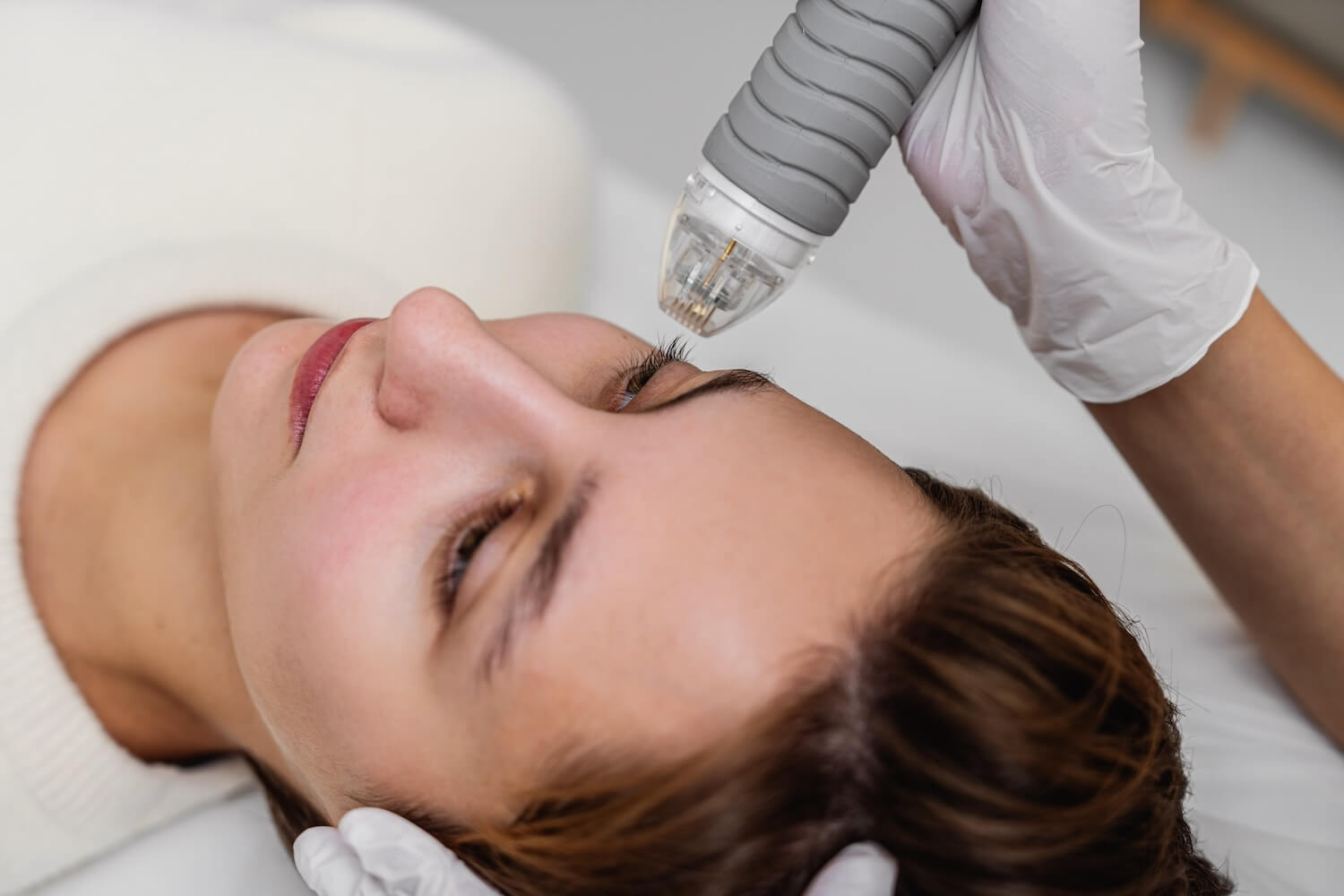Microneedling, a popular skincare treatment, has become a trusted method for addressing a variety of skin imperfections. Whether you’re struggling with acne scars, fine lines, hyperpigmentation, or texture issues, this minimally invasive procedure offers an innovative solution by stimulating your skin’s natural healing processes. But what exactly is microneedling, and how does it support skin rejuvenation?
In this comprehensive guide, we will explore how microneedling works, its benefits, and why it has earned such high praise from both skincare professionals and enthusiasts.
What Is Microneedling?
Microneedling, also known as collagen induction therapy (CIT), is a non-surgical treatment that involves using tiny, sterile needles to create controlled micro-injuries in the skin’s surface. This process triggers the body’s natural wound healing mechanisms, stimulating collagen and elastin production. These proteins are vital for maintaining healthy, youthful-looking skin, as they contribute to skin elasticity, smoothness, and overall vitality.
While the concept of microneedling dates back to the early 1990s, it has seen a resurgence in recent years due to advancements in technology, making the treatment safer, more effective, and accessible. The procedure is typically performed using a dermaroller or a more advanced microneedling pen, which creates precise channels in the skin to encourage healing.
How Does Microneedling Work?
At its core, microneedling is all about stimulating the skin’s natural repair mechanisms. When the tiny needles puncture the skin, they create microchannels or tiny injuries that the body needs to heal.
This process has several key skincare stages:
- Collagen Production: The skin responds to the micro-injuries by producing more collagen and elastin, two proteins essential for maintaining youthful and healthy skin. Collagen helps to firm and plump the skin, reducing the appearance of wrinkles, fine lines, and scars.
- Cell Turnover: Microneedling accelerates cell turnover, allowing for the renewal of skin cells. This results in smoother skin and a more even skin tone, helping to fade dark spots, hyperpigmentation, and acne scars.
- Improved Blood Flow: The treatment increases blood flow to the treated area, promoting better oxygenation and nutrient delivery to the skin. This boosts the skin’s ability to repair itself and heal faster.
- Enhanced Absorption: The microchannels created by the microneedling process allow for better absorption of skincare products. Active ingredients such as hyaluronic acid, peptides, and vitamin C can penetrate deeper into the skin, making the post-treatment skincare routine even more effective.
The Benefits of Microneedling
Microneedling has a wide range of benefits that make it a highly sought-after treatment in both professional skincare clinics and at-home regimens. Whether you’re dealing with specific skin concerns or looking for an overall skin boost, microneedling can help in several ways:
1. Improves Skin Texture and Tone
One of the most popular reasons people turn to microneedling is its ability to enhance skin texture and tone. By stimulating collagen production and increasing skin cell turnover, microneedling helps to create smoother skin. It can significantly reduce rough patches, scars, and uneven skin tones. Whether you have enlarged pores, acne scars, or fine lines, the treatment works by smoothing out imperfections and revealing more even skin. It’s particularly beneficial for individuals with textured skin due to previous skin damage or acne.
2. Reduces the Appearance of Scars
Microneedling is particularly effective for treating acne scars and other types of scarring, such as those from surgery or injury. The controlled micro-injuries cause the skin to regenerate, helping to break down scar tissue and encouraging the formation of new, healthier skin. The process softens the appearance of scars and can eventually lead to a much more even complexion. Notably, deep scarring may require more than one session for full results, but many individuals notice visible improvements in texture after just a few treatments.
3. Minimizes Fine Lines and Wrinkles
As we age, our skin naturally loses collagen and elastin, two essential proteins that keep our skin firm and youthful. Microneedling can help reverse some of these age-related changes by stimulating collagen production. It can help reduce the appearance of fine lines and wrinkles, especially around areas that are prone to expression lines, such as the forehead, eyes, and mouth.
Microneedling is often favored over traditional chemical peels or laser resurfacing for individuals with sensitive skin or those seeking a more subtle, natural rejuvenation. Its gentle yet effective approach to wrinkle reduction makes it an excellent choice for those looking to maintain a youthful appearance without the need for invasive procedures.
4. Helps with Hyperpigmentation
Hyperpigmentation, which includes dark spots, age spots, and sun damage, is a common concern for many. Microneedling helps promote an even skin tone by triggering the skin’s healing process. As the skin regenerates, it works to reduce the production of excess melanin, which can fade dark spots and brighten the overall complexion. This can be especially beneficial for individuals with sun-damaged skin or those suffering from melasma, a condition that causes dark patches on the skin.
5. Boosts Product Absorption
Microneedling creates tiny channels in the skin, which increases the absorption of topical skincare products. After the procedure, many people use hydrating serums or other treatments to enhance the effects of the microneedling. This increased absorption allows the active ingredients in serums to penetrate deeper into the skin, making the post-treatment care more effective. Whether you use a growth factor serum, a vitamin C serum, or a hyaluronic acid product, microneedling maximizes the results of your skincare routine.
6. Improves Skin Hydration
Microneedling can also improve skin hydration. By creating tiny wounds and increasing circulation, the treatment helps the skin retain moisture. This is particularly beneficial for those with dry or dehydrated skin, as the increased hydration can leave the skin feeling plumper and more nourished. Additionally, post-treatment hydrating masks or serums can enhance skin moisture retention and restore a healthy glow.
What Skin Concerns Can Microneedling Treat?
Microneedling is a versatile treatment that can address a wide variety of skin concerns. Below are some of the most common issues that people seek to address with this treatment:
- Acne Scars: Microneedling is one of the most effective treatments for reducing the appearance of acne scars. It helps break down the scar tissue and stimulates the skin’s repair process to create smoother skin.
- Fine Lines and Wrinkles: As mentioned earlier, microneedling can significantly reduce the appearance of fine lines and wrinkles, making it an effective anti-aging treatment.
- Hyperpigmentation: Dark spots, sun damage, and melasma can be improved through microneedling by stimulating the skin to renew itself.
- Stretch Marks: Similar to scars, stretch marks can also be improved with microneedling, as the treatment helps regenerate the skin and smooth out the appearance of stretch marks.
- Enlarged Pores: By stimulating collagen production around pores, microneedling can reduce the size of enlarged pores, leading to a smoother appearance. This is particularly beneficial for those with oily or combination skin types.
What to Expect During and After a Microneedling Treatment Sessions
1. Before the Treatment
Before you undergo microneedling, it’s essential to have a consultation with a licensed skincare professional. During this consultation, they will assess your skin type, discuss your skin concerns, and create a customized treatment plan for you. It’s also recommended to stop using any active ingredients like retinoids or acids for a few days prior to the treatment to minimize irritation.
2. The Treatment
The microneedling procedure itself typically takes around 30 minutes to an hour, depending on the size of the treatment area. A topical numbing cream will be applied to your skin to ensure comfort during the treatment. While microneedling can cause slight discomfort, it is generally well-tolerated. The sensation is often compared to the feeling of mild pinpricks or light scratching.
3. After the Treatment
After the procedure, your skin may appear slightly red or flushed, similar to a mild sunburn. This is normal and should subside within a few hours. You may also experience some slight swelling, but this will typically diminish within a day or two. It’s important to follow the aftercare instructions provided by your practitioner, which may include avoiding direct sun exposure and refraining from applying makeup for at least 24 hours.
In the first 24-48 hours after the treatment, your skin will be in repair mode, so it’s vital to avoid activities that could irritate the skin, such as excessive sweating or using harsh skincare products. You should also refrain from using any strong exfoliants until your skin has fully healed.
Microneedling Results: When to Expect to See Improvements
While results vary from person to person, many individuals notice improvements in skin texture and tone after just one treatment. However, for more significant results—such as the reduction of deep acne scars or wrinkles—several sessions may be necessary. Typically, a series of three to six microneedling treatments spaced about four to six weeks apart is recommended to achieve optimal results.
The full benefits of microneedling will continue to emerge over time as collagen production peaks. Most people see noticeable improvements within 4 to 6 weeks after their final treatment, with skin becoming smoother, more even, and youthful-looking.
Conclusion
Microneedling is an effective and versatile skincare treatment that addresses a wide range of concerns, from acne scars to fine lines and hyperpigmentation. By stimulating the skin’s natural healing processes, it encourages collagen production, leading to smoother, more youthful skin. With minimal downtime and long-lasting results, microneedling is a valuable tool in your skincare regimen. If you’re considering microneedling, consulting with a professional is the first step toward achieving the healthy, radiant skin you’ve always wanted.

